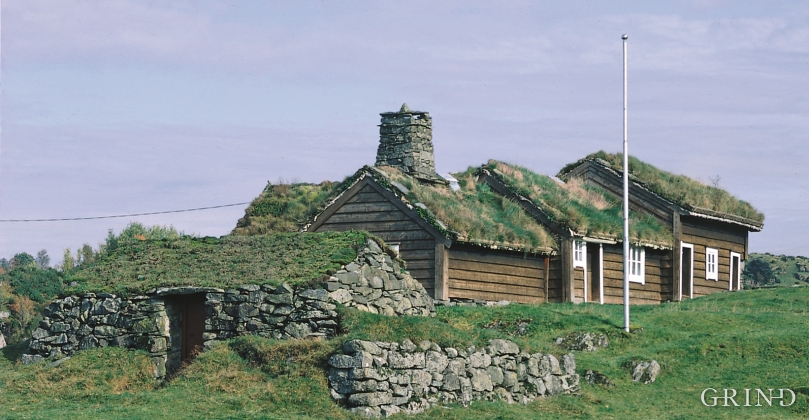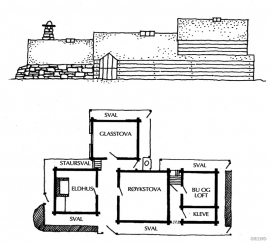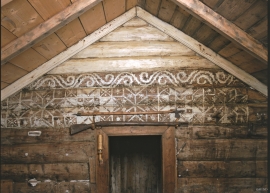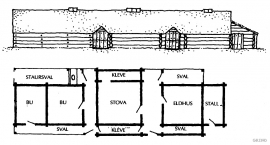Publisert: 15.02.2013 | Forfattar: Nils Georg Brekke
Bogatunet (Helge Sunde).
In the lightly undulating landscape at Boga there lies an old house with several rooms on a small rise. In fact it looks like three houses built into one another; a scullery, a living room and a store with a loft. From other sources we know that this house had covered passageways and sheds round all the walls in the 19th century; a compressed “long house” with inter-connections between all the rooms. This is a building style from the Middle Ages that we see traces of; a building corresponding to those we have seen remains of at Høybøen in Fjell and Lurekalven in Lindås. Bogatunet was restored in 2006.
The multiple roomed house at Boga shows us a style of building which must have been a feature of the coastal villages for many centuries. Parts of this building probably go back to the 17th century. According to tradition a loft was built above the store in 1735, and in 1818 a room with a window was built on the east side. When the hearth was replaced by an iron oven at the end of the 19th century, the covered passageways were pulled down and windows were put into the walls.
The style of settlement was closely related to people’s way of subsistence. Natural resources from the sea and the land were used with great care and consideration. The cultural landscape at Boga with its home fields, its rough grazing, stonewalls, paths, copses and boat-sheds give us a close up picture of a little farm on the west coast.
If we used the term “ecological” building style, we could not find a better term to describe the long house at Boga. The covered passageways which, in the late autumn, were full of peat, wood and poles, provided insulation for the rooms inside. The hearth room was the main kitchen, the living room was where people lived and in the store they kept the food whilst the beds were in the loft. The loft was pulled down in 1905 but when the Nord and Midthordland Historical Society took over the building in 1920, the loft was reconstructed. A jointed hayshed was built up on old remains, and down on the fjord there was a fine boat shed environment.
In the hearth room there is a decorative table painted with a mixture of chalk, lime and water. The decorative painting as it was known is probably linked to medieval decorative traditions; knots, rosettes and eight petalled roses which resemble the pattern on an old woven wall hanging. When the living room was washed and sanded for a celebration and festivities, it was usual to decorate a couple of the planks around the room.
- Kvalheim, G. (1981) Bogatunet i Manger. I: Frå Fjon til Fusa: årbok for Nord- og Midthordland sogelag. Bergen, Sogelaget, s. 143-152.






